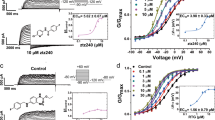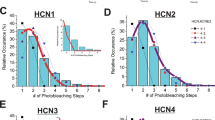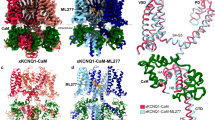Abstract
The Shaker family voltage-dependent potassium channels (Kv1) are expressed in a wide variety of cells and are essential for cellular excitability. In humans, loss-of-function mutations of Kv1 channels lead to hyperexcitability and are directly linked to episodic ataxia and atrial fibrillation. All Kv1 channels assemble with β subunits (Kvβs), and certain Kvβs, for example Kvβ1, have an N-terminal segment that closes the channel by the N-type inactivation mechanism. In principle, dissociation of Kvβ1, although never reported, should eliminate inactivation and thus potentiate Kv1 current. We found that cortisone increases rat Kv1 channel activity by binding to Kvβ1. A crystal structure of the Kvβ-cortisone complex was solved to 1.82-Å resolution and revealed novel cortisone binding sites. Further studies demonstrated that cortisone promotes dissociation of Kvβ. The new mode of channel modulation may be explored by native or synthetic ligands to fine-tune cellular excitability.
This is a preview of subscription content, access via your institution
Access options
Subscribe to this journal
Receive 12 print issues and online access
$259.00 per year
only $21.58 per issue
Buy this article
- Purchase on Springer Link
- Instant access to full article PDF
Prices may be subject to local taxes which are calculated during checkout





Similar content being viewed by others
References
Adelman, J.P., Bond, C.T., Pessia, M. & Maylie, J. Episodic ataxia results from voltage-dependent potassium channels with altered functions. Neuron 15, 1449–1454 (1995).
Olson, T.M. et al. Kv1.5 channelopathy due to KCNA5 loss-of-function mutation causes human atrial fibrillation. Hum. Mol. Genet. 15, 2185–2191 (2006).
Long, S.B., Campbell, E.B. & MacKinnon, R. Crystal structure of a mammalian voltage-dependent Shaker family K+ channel. Science 309, 897–903 (2005).
Scott, V.E. et al. Primary structure of a beta subunit of alpha-dendrotoxin-sensitive K+ channels from bovine brain. Proc. Natl. Acad. Sci. USA 91, 1637–1641 (1994).
Gulbis, J.M., Zhou, M., Mann, S. & MacKinnon, R. Structure of the cytoplasmic beta subunit-T1 assembly of voltage-dependent K+ channels. Science 289, 123–127 (2000).
Sokolova, O. et al. Conformational changes in the C terminus of Shaker K+ channel bound to the rat Kvbeta2-subunit. Proc. Natl. Acad. Sci. USA 100, 12607–12612 (2003).
Nagaya, N. & Papazian, D.M. Potassium channel alpha and beta subunits assemble in the endoplasmic reticulum. J. Biol. Chem. 272, 3022–3027 (1997).
Rhodes, K.J. et al. Voltage-gated K+ channel beta subunits: expression and distribution of Kv beta 1 and Kv beta 2 in adult rat brain. J. Neurosci. 16, 4846–4860 (1996).
Weng, J., Cao, Y., Moss, N. & Zhou, M. Modulation of voltage-dependent shaker family potassium channels by an aldo-keto reductase. J. Biol. Chem. 281, 15194–15200 (2006).
Pan, Y., Weng, J., Cao, Y., Bhosle, R. & Zhou, M. Functional coupling between the Kv1.1 channel and an aldo-keto reductase Kvbeta1. J. Biol. Chem. 283, 8634–8642 (2008).
Heinemann, S. et al. The inactivation behaviour of voltage-gated K-channels may be determined by association of alpha- and beta-subunits. J. Physiol. (Paris) 88, 173–180 (1994).
Zagotta, W.N., Hoshi, T. & Aldrich, R.W. Restoration of inactivation in mutants of Shaker potassium channels by a peptide derived from ShB. Science 250, 568–571 (1990).
Hoshi, T., Zagotta, W.N. & Aldrich, R.W. Biophysical and molecular mechanisms of Shaker potassium channel inactivation. Science 250, 533–538 (1990).
Zhou, M., Morais-Cabral, J.H., Mann, S. & MacKinnon, R. Potassium channel receptor site for the inactivation gate and quaternary amine inhibitors. Nature 411, 657–661 (2001).
del Camino, D., Holmgren, M., Liu, Y. & Yellen, G. Blocker protection in the pore of a voltage-gated K+ channel and its structural implications. Nature 403, 321–325 (2000).
Isacoff, E.Y., Jan, Y.N. & Jan, L.Y. Putative receptor for the cytoplasmic inactivation gate in the Shaker K+ channel. Nature 353, 86–90 (1991).
Gulbis, J.M., Mann, S. & MacKinnon, R. Structure of a voltage-dependent K+ channel beta subunit. Cell 97, 943–952 (1999).
Heinemann, S.H., Rettig, J., Graack, H.R. & Pongs, O. Functional characterization of Kv channel beta-subunits from rat brain. J. Physiol. (Lond.) 493, 625–633 (1996).
Shi, G. et al. Beta subunits promote K+ channel surface expression through effects early in biosynthesis. Neuron 16, 843–852 (1996).
Accili, E.A., Kuryshev, Y.A., Wible, B.A. & Brown, A.M. Separable effects of human Kvbeta1.2 N- and C-termini on inactivation and expression of human Kv1.4. J. Physiol. (Lond.) 512, 325–336 (1998).
Gu, C., Jan, Y.N. & Jan, L.Y. A conserved domain in axonal targeting of Kv1 (Shaker) voltage-gated potassium channels. Science 301, 646–649 (2003).
Wells, J.A. & McClendon, C.L. Reaching for high-hanging fruit in drug discovery at protein-protein interfaces. Nature 450, 1001–1009 (2007).
Rhodes, K.J. et al. Association and colocalization of the Kvbeta1 and Kvbeta2 beta-subunits with Kv1 alpha-subunits in mammalian brain K+ channel complexes. J. Neurosci. 17, 8246–8258 (1997).
Sewing, S., Roeper, J. & Pongs, O. Kv beta 1 subunit binding specific for shaker-related potassium channel alpha subunits. Neuron 16, 455–463 (1996).
Otwinowski, Z. & Minor, W. Processing of X-ray diffraction data collected in oscillation mode. Methods Enzymol. 276, 307–326 (1997).
Vagin, A. & Teplyakov, A. An approach to multi-copy search in molecular replacement. Acta Crystallogr. D Biol. Crystallogr. 56, 1622–1624 (2000).
Brünger, A.T. et al. Crystallography & NMR system: a new software suite for macromolecular structure determination. Acta Crystallogr. D Biol. Crystallogr. 54, 905–921 (1998).
Schuttelkopf, A.W. & van Aalten, D.M. PRODRG: a tool for high-throughput crystallography of protein-ligand complexes. Acta Crystallogr. D Biol. Crystallogr. 60, 1355–1363 (2004).
Jones, T.A., Zou, J.Y., Cowan, S.W. & Kjeldgaard, M. Improved methods for building protein models in electron density maps and the location of errors in these models. Acta Crystallogr. A 47, 110–119 (1991).
Laskowski, R.A., MacArthur, M.W. & Thornton, J.M. Validation of protein models derived from experiment. Curr. Opin. Struct. Biol. 8, 631–639 (1998).
Kabsch, W. A solution for the best rotation to relate two sets of vectors. Acta Crystallogr. A 32, 922–923 (1976).
Acknowledgements
We thank R. MacKinnon (Rockefeller University) for advice and generous help throughout the project. We thank C. Deutsch (University of Pennsylvania) and C. Miller (Brandeis University) for critical comments on the manuscript. Data for this study were measured at beamlines X4A, X4C and X29 of the National Synchrotron Light Source. We thank J. Schwanof, R. Abramowitz, S. Myers, N. Whalen and R. Jackimowicz for technical support during data collection. This work was supported by the American Heart Association (0630148N to M.Z. and 0826067D to Y.P.), the US National Institutes of Health (HL086392 to M.Z.), the March of Dimes Birth Defects Foundation (research grant #5-FY06-20 to M.Z.) and a grant from the Pew Scholars Program (to M.Z.).
Author information
Authors and Affiliations
Corresponding author
Supplementary information
Supplementary Text and Figures
Supplementary Figures 1–3, Supplementary Table 1 and Supplementary Methods (PDF 229 kb)
Rights and permissions
About this article
Cite this article
Pan, Y., Weng, J., Kabaleeswaran, V. et al. Cortisone dissociates the Shaker family K+ channels from their β subunits. Nat Chem Biol 4, 708–714 (2008). https://doi.org/10.1038/nchembio.114
Received:
Accepted:
Published:
Issue Date:
DOI: https://doi.org/10.1038/nchembio.114
This article is cited by
-
Corticosteroids and aldose reductase inhibitor Epalrestat modulates cardiac action potential via Kvβ1.1 (AKR6A8) subunit of voltage-gated potassium channel
Molecular and Cellular Biochemistry (2017)
-
Kv4 channels underlie A-currents with highly variable inactivation time courses but homogeneous other gating properties in the nucleus tractus solitarii
Pflügers Archiv - European Journal of Physiology (2015)
-
To dislodge an enzyme from an ion channel, try steroids
Nature Chemical Biology (2008)



